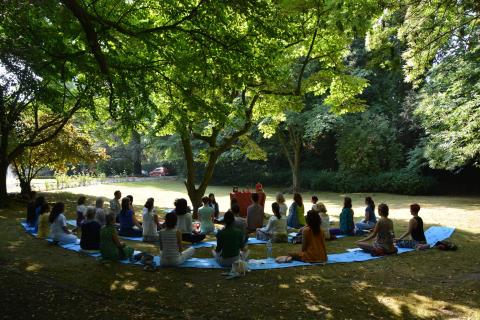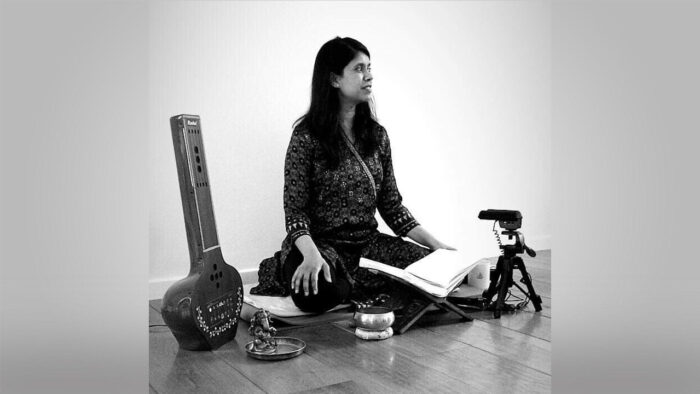The first time I understood the essence of a mantra was when I lived at the Sivananda Ashram in Uttarkashi. Being born and raised in India, I grew up listening to Sanskrit chanting from various sources — in school, at a friend’s home puja, in asana classes as the opening and closing chants. The difference at the ashram was that we had a teacher explain the meaning of mantra and how each sound, each syllable has a precise value and an effect on our gross and subtle mind and body.
I often hear Sanskrit teachers talk about the importance of Sanskrit pronunciation and it’s only when I started chanting that I realised why this accuracy is essential. Sanskrit is the language of yoga and like all things associated with yoga, it is a science and for it to work, one has to create the correct conditions. As chanting is a verbal science, the correct pronunciation, diction and adherence to rules is necessary for one to receive its benefits. The best way to approach chanting (or any other aspect of yoga) is to find the right teacher. I discovered Belgium-based Shantala Sriramaiah when I was working on Indica Yoga’s Global Festival of Yoga. Her in-depth understanding and love for Veda Chanting has been passed on to her from her mother and she’s dedicated her life to teaching Veda chanting. In this interview, Shantala shares why it’s important to follow the rules of chanting, how to chant correctly, the benefits of chanting and why mantra chanting is an integral part of yoga and an effective way to become close to Īśvara.
Sophia: You left a 20-year career in engineering to start teaching and sharing the knowledge of the Vedas through chanting. Tell us about that transition?
Shantala: The more I reflect, the more it feels like a natural evolution of my career. I spent about 20 years in the technology sector specialising in Learning & Development. I was very fortunate to have worked with brilliant colleagues and learnt from the best on delivering online training solutions as well as instructional design, developing learning resources and also delivering technology training. I will always remember very fondly my years as a tech trainer, the most fun years I spent as a young professional. I never imagined that one day I would use these skills for Veda chanting. When my mother, who was also a chanting teacher, passed away in 2012, that was the point in life when I wished to continue her work, in my own way. So, on the one hand it seems like a big change from the corporate world and technology, on the other hand it was a natural progression of learning all the skills I would need to eventually build on my mother’s legacy, but using technology and resources that can reach a wider audience in the convenience of their homes. The subject matter changed from technology to Veda.
Sophia: Tell us about your bond with your mother and how she inspired your interest in Vedic chanting?
Shantala: My mother Saroja, was quite the force. She was my first chanting teacher. She taught my brother and I a Dhanvantari mantra to chant everyday when we were really small kids, that was the start for me. She used to teach her classes in our living room so I had a ring-side view of how she created an amazing community and how she taught and inspired her students. In later years, she was teaching at many cultural and community centres. She organised very large events always honouring her teachers and spent literally all her time immersed in devotional chanting. At the time of her death, her students gathered outside our home, chanting, it was an inspiring moment to realise that she shared something of great value with her community.

My mother Saroja teaching a chanting class in our home in Bengaluru
Sophia: What are the challenges and benefits of teaching Vedic mantras to Western students?
Shantala: When I decided to start teaching chanting, I was already based in Belgium and naturally an international community of mainly yoga teachers started coming to my classes. I have learnt a lot from my students who represent over 30 different nationalities. They have taught me what some of the practical challenges of chanting can be for various languages. Since going online with my teaching, many Indian students also join me for the same classes. A universal challenge, whether Indian or Western is maintaining “svara” - one of the chanting rules, precisely chanting the correct notes of mantra. As an Indian raised in a traditional spiritual family, perhaps my examples or explanations may not always translate well for a Western audience. I spend a lot of time on my own study and reflection to be able to add value to students from all backgrounds. I have Polish and American students who prefer to read a text in Devanāgari and many Indians who prefer English transliteration. In general it is easier for Indians to pronounce Sanskrit sounds, but equally, I have many Western students highly competent in Sanskrit! It has been a great learning experience for me and I continue to learn from my students, who are very gracious in receiving corrections and feedback.

Chanting class in Brussels
Sophia: On your website, you say you formally initiate students into Vedic Chanting. Can you elaborate on that?
Shantala: Vedic chanting requires systematic teaching and an introduction to the framework of rules to honour. Even those proficient in Sanskrit as a language do not normally learn the Vedic phonetics of Veda recitation in their classical Sanskrit studies. Therefore, I offer a Foundation Programme in Vedic Chanting. In five weeks, I take students through the most important short mantras, for which there are unfortunately various versions available on popular media. I teach mantras for peace, invocation to Gaṇapati & Sarasvatī and japa mantras with accurate text and numerous learning resources on the Veda Studies platform along with a comprehensive workbook with exercises and Vedic phonetic guides for each mantra. I enjoy working with students individually in this course as they send me a recording each week after the live class. Students receive specific feedback and corrections ensuring the learning is effective. These five weeks are important and sacred for me and my goal is to make as many people fall in love with this practice as possible! Students are able to experience what it takes to be proficient in this practice and the level of focus and accuracy the tradition is known for. Students also become familiar with the Veda Studies system of representing all the Veda chanting rules — a colour coded system I devised so they can ensure accuracy and understanding of the rules. At the end of this programme, participants have learnt the most important mantras for daily practice and are ready to start learning Sūktams if they wish to progress further.

Veda studies system
Sophia: What are some of the benefits of chanting and how does it complement an asana practice?
Shantala: Chanting has many benefits starting from the immediate feeling of well-being one experiences to the long-term benefits of living a prayerful life. Chanting is a process of developing our breath and extending the exhalation. I call it an Īśvara infused prāṇāyāma! One requires complete focus for Veda chanting and many of my students who are yoga teachers tell me that this is one of the best tools for one-pointed concentration. I like helping practitioners understand how the Veda is the source text for yogic practices. Every subtle concept in traditional yoga like Śraddhā, Tapas or Sṃrti is a Vedic deity with Sūktams dedicated to develop those qualities — Śraddhā Sūktam, Agni Sūktam, Medhā Sūktam etc. The Ṛṣi-s of the Veda show us mantras for health and well-being that are holistic with the importance of prayer clearly highlighted. All of these are a wonderful complement to those wanting to infuse their āsana practice with a prayerful aspect and honour the roots of yoga.
Sophia: How can we distinguish between the science of chanting and its religious connotation? Is this distinction necessary?
Shantala: Personally for me this distinction is not necessary. While I was raised in a Hindu traditional family, most of my students are not and this has never been a challenge. I follow the Hindu calendar for our community events organising specific chanting events for Gaṇeśa festival, Dīpāvali or Navarātri. This is the best way to organise our days/weeks/months and to know which mantras to practice, enjoy and benefit from. This Navarātrī, my family organised a virtual tour of the gombe (doll) festival for our students. I have shared pictures from my brother’s and nephews’ upanayanam (thread ceremony) to highlight the sacred approach to Gāyatrī mantra practice. We usually have over a 100 participants for our community events and my openness to sharing Hindu rituals and practices are well-received. There is no other obligation expected from students, it is simply a loving and personal sharing of the context of mantra chanting. I am very grateful to our student community for their enthusiasm and encouraging words at these events.

My brother’s (Hari Sriramaiah) upanayanam ceremony
Sophia: What would be your advice to someone who wants to start learning Sanskrit and Vedic chanting?
Shantala: The main advice I give students in my Foundation course is to cultivate a joyful daily consistent practice. It is not possible to learn Vedic chanting otherwise. One needs to be very detail oriented and enjoy repetition over a long period of time. There are no secrets, just a daily practice. It takes many years to become competent with Veda chanting. Therefore, my teacher always highlights the importance of having Śraddhā in one’s practice, a sincere dedication and commitment to the tradition and practice.
Sophia: Who are the teachers and scholars that inspired and informed your journey to becoming a Vedic chanting teacher?
Shantala: I am very blessed and honoured to be a student of Sri M.S. Sreenivasan of The Challakere Brothers. Without his support and encouragement, Veda Studies would not exist. Through his own life and practice and respect for his Gurus, he is an inspiration in devotion, dedication and absolute focus in living a life of this tradition. I’m eternally grateful to have such a mentor.
I have the privilege of studying with SAKSHI institute in Bangaluru. Both Prof. R.L Kashyap (recently awarded the Padmasri for his contribution to literature & education) and Dr. Jahagirdar have helped me understand the significance of Veda mantras for practical application in daily life. I’m very grateful that the team at SAKSHI supports my endeavour.
My Vedanta teachers Neema & Surya, disciples of Swami Dayananda Saraswati of Arsha Vidya Ashram helped me understand how chanting Veda mantras allows more Īśvara into our lives, helping us connect to the divine and live a prayerful life full of blessings.
My mother’s Guru Mata Anantalakshmi still receives me as if I am my mother, she tells me I am Saroja (my mother’s name) and has taught me Soundarya Lahiri and Devī Mahātmyam etc.
My Sanskrit teacher Mrs Goda Gopal has been a great support to me and knows me since I was eight years old. She and my mother were great friends talking late into the night about Rāmāyaṇa.
There are numerous other teachers who have inspired and supported me through the years including the late Radha Sundararajan (ex-KYM) who helped me understand the role of Vedic chanting in health and well-being. My late friend Jean Le Mée, author of Hymns from the Rig Veda has been such a source of inspiration. My late aunt Sujata was a Sanskrit scholar and lived with us while she was studying her Masters. I remember reading Amar Chitra Katha (Indian devotional/hindu stories in comic form) with her and reading the epics in Sanskrit with her. Our Sanskrit teacher from my school Sri Suryanarayana was my first Sanskrit influence and I remember loving this class so much!
My father has helped build my Veda Studies library, sponsoring all of the books I need for study and reference.
There are too many other teachers to name here, but my gratitude is immense.

Chanting in our family home to honour my mother’s memory
Sophia: Can you tell us about the significance and benefits of chanting the primordial sound Om?
Shantala: There are many resources that explain beautifully about the benefits of Oṃ chanting. Speaking from my personal perspective, every mantra, every Sūktam, every hymn in the Veda is basically an expansion of Oṃ. Through Oṃ we connect with and understand Īśvara as the network of natural laws that govern the Universe. As my teachers say, understanding Īśvara allows us to live life intelligently, navigating the ups and downs of life gracefully.
Sophia: What is your favourite mantra(s) and why?
Shantala: I am guilty of being inspired by and finding every mantra to be my favourite. If you speak to my students, they will tell you that I say “this is my favourite mantra” for all mantras! Having understood the significance and relevance of mantras for different occasions or serving specific functions, they are indeed all my favourite. My daily practice is the Gāyatrī mantra, but every class I teach, every Sūktam I share, chanting Rudram every week and every japa with my community class, I love. I pray constantly to the divine, for the gift of time in my busy householder life, so my daily practice may continue without interruption.

Chanting class at the Indian Embassy in Brussels.
For further information about Shantala’s classes, visit Veda Studies





